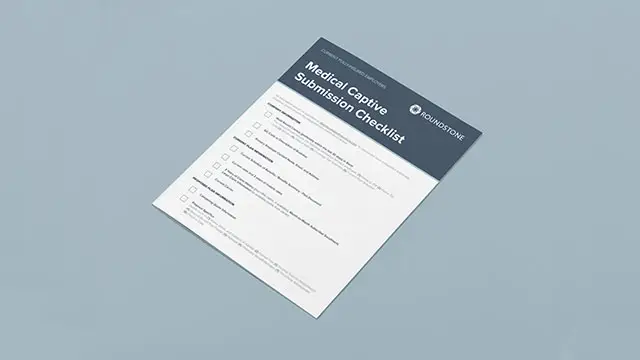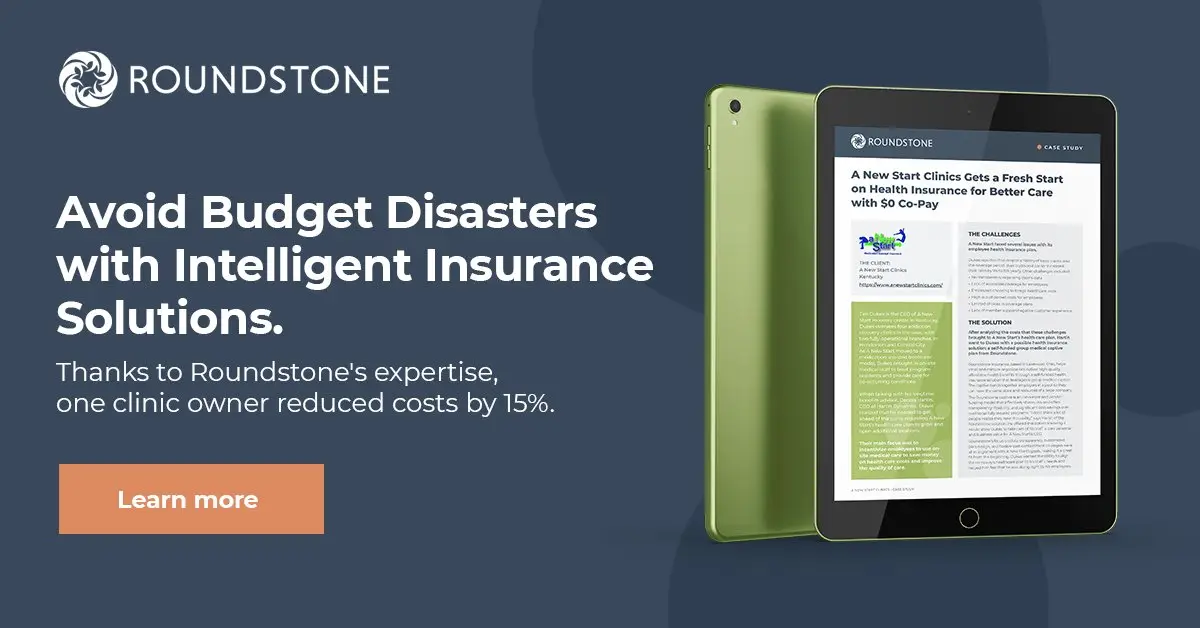Highlights
- The best health insurance for employees provides customized service options at an affordable price.
- Unlike traditional fully insured plans, self-insurance gives you control over plan design and cost containment solutions, letting you tailor coverage for your employees’ needs.
- Self-funded insurance lets you negotiate rates and use providers of your choice, helping you find solutions that work for your budget and employee health concerns.
- With Roundstone’s group captive stop-loss insurance, you can provide coverage for primary care, telemedicine, and well-being programs to support your team’s health and improve employee satisfaction.
As healthcare expenses continue to rise, maintaining and attracting your workforce requires providing affordable and accessible employee health benefits.
In a recent study by the Society for Human Resource Management, 90% of survey respondents cited healthcare as an extremely or very important employee benefit. And in a study by the Society for Human Resource Management, 60% of employees said employee benefits were extremely or very important when considering whether to stay with their current employer.
Choosing an employee health benefits plan that delivers quality healthcare services with manageable co-pays and deductibles has never been more critical.
At the same time, some companies opted for fully insured plans that offered healthcare coverage. However, these costs have surged in the last decade, with family premiums increasing by nearly 50% since 2013.
As the employer caught in the middle of these two seemingly impossible drivers, what can you do?
To combat these prices and continue to offer quality care, businesses are turning to alternative options for employee health benefits, like the self-funded model. This approach gives you direct control over your healthcare spending and plan design, allowing for more customized and cost-effective healthcare solutions.
Self-Insured vs. Fully Insured (Traditional) Models
Self-insured or self-funded plans are a customized way to provide health insurance. Under this model, you, the employer, bear the financial responsibility for your employees’ healthcare claims.
Instead of paying fixed premiums to an insurance company, you cover healthcare claims as they occur. This offers greater control over your healthcare spending, allowing you to design a plan that caters to your employees’ specific needs.
To reduce the risk of unexpectedly high claims under a self-insured plan, businesses buy stop-loss insurance and participate in a group medical captive. This type of insurance caps the amount you pay for individual or aggregate health claims, covering any expenses exceeding this cap.
Since you assume the risk of high claims with self-insurance, stop-loss coverage protects your finances from catastrophic or unforeseen medical expenses.
The trade-off is that while you take on some degree of risk management with self-insurance, you gain flexibility and cost savings compared to traditional insurance. If your claims are lower than expected, you get your unspent funds back at renewal time, allowing you to reinvest them.
Here’s a comparison of self-insurance versus fully insured plans to illustrate how each approach differs for employers:
| Mechanism | Self-Insurance | Fully Insured Plan |
| Financial Responsibility | Employer pays healthcare claims | Fixed premium paid to insurance company |
| Plan Administration | Typically administered via a third-party administrator (TPA) | Managed and administered by the insurance company |
| Plan Design Flexibility | High flexibility to customize plan to employee needs | Limited flexibility, plan options determined by insurer |
| Risk of High Claims | Employer assumes risk, often mitigated with stop-loss insurance | Insurance company assumes the risk |
| Employee Communication | Employer informs employees about plan details and changes | Communication typically handled by the insurer |
| Risk Management | Employer monitors and manages health risks, may use a group captive plan to combine funds with other like-size businesses to spread risk | Risk management is the insurer’s responsibility |
| Financial Management | Requires effective budgeting for anticipated and unforeseen costs | Employers pay a fixed premium, with less financial management involvement |
| Returned Premiums | Potential return of unspent funds at year-end | No return of premiums; fixed cost regardless of claims |
Self-Funding Offers Enhanced Plan Flexibility and Customization
Self-insured health plans for small businesses provide employers with improved flexibility and customization in health plan design for their employees’ medical benefits. Unlike traditional insurance, where the provider dictates plan options, self-funding allows you to build a plan that aligns with your workforce’s needs and preferences.
This flexibility in company healthcare means you can prioritize benefits that matter to your employees, leading to increased satisfaction and potentially better health outcomes. Tailoring your plan also helps control spending, letting you focus resources on the services your employees need.
Here are a few examples of how plan customization works under self-insurance and the benefits to you and your employees when it comes to your company’s healthcare benefits:
Lower Co-Pays
In a self-funded plan, you can design a structure that promotes lower co-pays for services like primary care. This incentivizes employees to choose cost-effective options over higher-cost services like urgent care. This approach encourages proactive healthcare management among employees while controlling overall expenses in an employer health program.

Telemedicine Options
Self-funding allows for the inclusion of telemedicine, providing employees with easy access to healthcare professionals via digital platforms in their employee wellness programs. This convenience can lead to increased use of healthcare services, enhancing employee wellness and potentially reducing the need for more expensive in-person visits.
Better Access to Primary Care
You can tailor your self-funded plan to offer better access to primary care, with options like direct primary care (DPC). This model allows for a flat monthly fee, giving employees access to more personalized care and longer appointments with their doctors.
In a 2021 survey, 30% of respondents said DPC enhanced their healthcare experience through increased time with their provider, and 59% said DPC offered better availability of care, reducing the need for more extensive healthcare services.
Self-Insurance Provides Access to Better Employee Health Benefits
Self-insurance also allows access to a more extensive network of healthcare providers. Unlike traditional insurance plans with their limited networks, self-funded plans allow you the freedom to negotiate with various healthcare professionals and facilities.
This means your employees aren’t restricted to a predefined list of providers. Instead, they can choose doctors and services that fit their individual health needs, leading to more personalized healthcare experiences.
Examples of the comprehensive healthcare options you can offer through self-insurance include:
- Broader specialist access. Employees have access to a wide range of specialists, ensuring they get the right care for their specific conditions.
- Advanced mental health services. The American Psychological Association found that in 2022, 81% of people were looking for workplaces that offered support for mental health. Self-insurance lets you incorporate comprehensive mental health support, including therapy and counseling services.
- Alternative treatment options. Offer coverage for alternative therapies like acupuncture or chiropractic care, providing a holistic way to manage their health.
- Customized care for chronic conditions. Tailor plans to include specialized care and management programs for chronic diseases like diabetes or kidney disease, improving long-term health outcomes.
Get Improved Transparency and Understanding with Self-Funded Insurance
With self-funded insurance, you can offer your employees improved transparency regarding their healthcare costs and coverage details. This is different from traditional insurance plans, which withhold claims information and leave you and your employees in the dark about where your money is going. With self-funding, you get a deeper understanding of what drives your healthcare costs in your company’s health plan.
In a self-funded model, you have direct access to all claims data. This transparency enables you to provide clear communication about healthcare spending, the reasoning behind coverage decisions, and detailed explanations of what is and isn’t covered under your employee health insurance plan.
For example, you can use real-time reports to show employees how their choices of generic vs. brand-name prescriptions impact costs, illustrating the savings to their out-of-pocket expenses and the overall plan expenditure.
This transparency provides your employees with the necessary information to make decisions about their healthcare. By understanding their healthcare costs, they develop a better appreciation of their employee medical benefits, so they feel more involved and confident in their healthcare choices.

Self-Funding Lets You Directly Impact Employee Healthcare Costs
With a self-funded plan, you can directly influence and reduce healthcare costs for your employees. Instead of facing premium increases in a standard plan, which have risen 22% in just five years, self-funding lets you tailor premiums and out-of-pocket expenses to better fit the financial needs of your workforce, improving both the savings and the quality of your employee health benefits.
You can achieve this goal through effective claims management. Direct access to claims data helps you identify spending trends and implement cost containment strategies, such as promoting preventive care or negotiating better rates with providers. This helps control costs and pass savings on to your employees.
A New Start Clinics’ switch to a self-funded insurance plan demonstrates the impact this model can have on employee healthcare costs. Previously burdened by rising rates and opaque coverage with traditional insurance, the transition led to direct primary care with no co-pays, reduced prescription costs, and lower out-of-pocket expenses.
Overall, the strategic change improved access to quality healthcare and resulted in a 15% reduction in healthcare costs for the company and its employees.
You Can Provide Enhanced Employee Health and Wellness Programs
Using a group health insurance plan for employees lets you implement comprehensive wellness programs and preventive care initiatives into your coverage. This promotes long-term health and well-being among employees, potentially leading to better health outcomes and lower healthcare costs.
A 2023 study found that participants in a university well-being program only saw a 32.6% increase in claims costs versus the 47.5% increase in those who did not participate.
Consider the following initiatives when designing a well-being program for your self-funded plan:
- Health screenings and assessments. These can help detect health issues like high blood pressure or vision issues early on, allowing for timely and often more effective treatment. Regular screenings encourage a culture of proactive health management among employees.
- Fitness and exercise programs. Initiatives like subsidized gym memberships or on-site fitness classes encourage physical activity, which helps improve employee health and reduce the risk of chronic diseases.
- Nutrition and weight management. Offering nutrition counseling and weight management programs can help employees adopt healthier eating habits and lifestyles. This benefits their health and can reduce the risk of diet-related diseases.
- Smoking cessation and substance abuse programs. Support in these areas can be life-changing, helping employees overcome addiction, improve their health, and reduce long-term healthcare costs regarding your company’s health benefits.

Self-Insurance Allows for Personalized Employee Support and Resources
Self-insurance allows for the integration of tailored support and resources for employees, boosting their interaction with healthcare benefits, and improving both the value and the savings of your company healthcare plan. This can take the form of dedicated teams or innovative tools tailored to healthcare benefit management.
For instance, a dedicated support team can assist employees with navigating their health plan, answering questions about coverage, and helping them make educated decisions about employee healthcare. This could include personalized guidance on selecting the most suitable healthcare providers, understanding complex medical bills, or planning for medical procedures.
You can offer digital tools like customized well-being apps, health trackers, or online portals. These platforms can give employees easy access to their health plan details, monitor healthcare spending, and offer wellness and preventive care resources. This can help make managing healthcare more accessible and less intimidating.
This level of personalized support simplifies the healthcare experience for employees and fosters a sense of being valued and cared for by their employers. It contributes to higher employee satisfaction and engagement with their employee medical benefits, helping to make self-funding the best health insurance for small businesses.
Self-Funding with Roundstone’s Group Captive Model
Roundstone’s group captive model presents an innovative approach to self-funding, offering a unique solution for affordable health insurance for employees. Our model operates by pooling together small and mid-sized businesses, allowing them to share risks and resources like a large corporation. This makes self-funded health plans more accessible, financially feasible, and effective for a broader range of businesses.
Key features and benefits of Roundstone’s model include:
- Risk sharing. By banding together, businesses in the captive share risks, leading to more stable and predictable healthcare costs. This shared risk model, pioneered by Roundstone in 2005, helps mitigate the impact of high-cost claims on any single member.
- Cost transparency. Roundstone offers a CSI Dashboard that provides detailed insights into healthcare spending and claims data. This transparency empowers you to make more data-driven decisions regarding healthcare plans.
- Customized plans. You have the flexibility to design health benefits tailored to the specific needs of your workforce, ensuring that the plan aligns with employee health requirements and budget constraints.
- Increased control. The model gives you greater control over your health plan design, administration, and costs, allowing you to directly influence the quality and scope of the healthcare provided.
- Administrative support. With Roundstone, you’re not alone in managing your self-funded plan. Your third-party-administrator (TPA) handles tasks like claims processing and compliance, while a dedicated Roundstone advisor helps identify issues and adjust your plan, simplifying the administrative process.
- Potential savings. As part of a self-funded plan, you benefit from the Roundstone Guarantee, where you receive 100% of unused premiums, leading to savings within the first five years. Roundstone has returned $72 million in premiums to members over the last 20 years, highlighting the model’s effectiveness in cost management.
Small business success stories with Roundstone include:
Roundstone
We implemented our own group captive model, which resulted in stable premiums for eight consecutive years, contrasting with rising industry trends. This stability in healthcare costs, coupled with the company’s growth and customized benefits, suggests effective cost management and enhanced employee satisfaction.
Totem Solutions
Totem Solutions saved over $6,000 in their first year after adopting Roundstone’s group medical captive plan. This transition, which included a direct primary care and zero-deductible plan, contributed to their recognition as one of the best workplaces in 2021 by INC Magazine, indicating improved employee well-being and satisfaction.
United Food Bank
With Roundstone’s model, United Food Bank implemented zero co-pays and immediate access to quality care, leading to lower costs and improved preventive care utilization. This approach likely resulted in fewer health emergencies and long-term cost savings, positively impacting employee health and reducing overall healthcare expenses.
Get the Best Health Insurance for Your Employees With Roundstone
ROUNDSTONE is an innovative employee health benefits company. We help small and midsize organizations offer competitive benefits at a lower cost by self-funding health insurance through our group medical captive. The Roundstone Captive enables companies to self-insure safely by pooling hundreds of employers together to share risk and save money.
With easy onboarding and personalized support every step of the way, the Captive offers control, flexibility, transparency, and returns all savings back to employers where they belong. We believe in always aligning with the employers’ best interests and remain committed to our mission — quality, affordable healthcare and a better life for all.
Download our free guide to learn what the traditional insurance companies don’t want you to know. Give your employees better health coverage for lower costs with a group captive plan from Roundstone.














